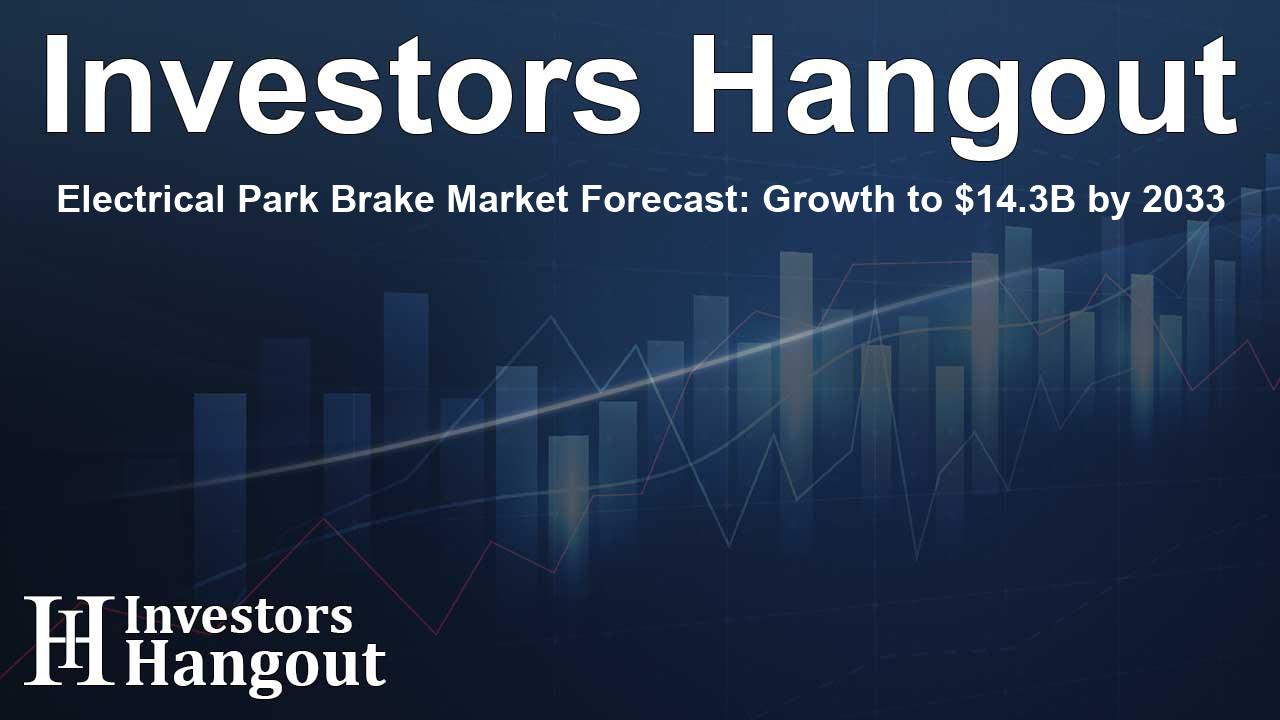Electrical Park Brake Market Forecast: Growth to $14.3B by 2033

The Rapid Growth of the Electrical Park Brake Market
Electrical Park Brakes (EPB) are increasingly becoming a staple in modern vehicles. The market is expected to experience significant growth over the next several years, with Allied Market Research forecasting an increase from a current valuation of approximately $3.5 billion in 2023 to a staggering $14.3 billion by 2033. This growth represents a compound annual growth rate (CAGR) of 15.6% from 2024 to 2033, indicating a robust expansion trend in the automotive industry.
Factors Driving Market Expansion
Several key factors contribute to the burgeoning electrical park brake market. Primarily, the automotive industry's shift towards electrification significantly accelerates market growth. Electric and hybrid vehicles often integrate advanced safety features, including EPBs, thus driving demand. Furthermore, consumers today have a growing preference for technologically integrated and convenient driving solutions.
Technological Advancements and Consumer Trends
Technological advancements in electronic braking systems enhance both safety and efficiency, allowing manufacturers to create lighter and more compact solutions. As a result, EPB systems not only contribute to improved vehicle design but also support fuel efficiency. The demand for enhanced safety features in vehicles further seeks to drive the market, as these systems provide reliable performance.
Challenges and Restraints
Despite the promising growth trajectory, the market does face challenges. Maintenance issues and high initial costs can hinder widespread adoption. The complexity of integrating EPBs with existing vehicle technology may also pose difficulties for manufacturers. However, addressing these concerns through innovation and improved solutions could yield new opportunities for the industry.
Market Segmentation Analysis
Segment analysis reveals insightful details regarding market dynamics. By type, the caliper integrated systems segment has secured a commanding share, accounting for nearly three-fourths of the EPB market revenue in 2023. This segment is particularly favored due to its space-saving capabilities and advancements in electronic braking technologies. It is projected to attain a CAGR of 16.0% through 2033, outpacing other segments.
Vehicle Segmentation Insights
Analyzing by vehicle type, passenger vehicles lead the market, comprising a substantial portion of EPB revenue. This segment is also expected to grow at a considerable rate, with an anticipated CAGR of 15.9% from 2024 to 2033. With the rise in electric vehicle adoption, the integration of EPBs will continue to evolve, as they complement other automated features increasingly desired by consumers.
Sales Channel Breakdown
When examining sales channels, OEM segments currently dominate, contributing over 80% of EPB revenue. The OEM segment is projected to grow at a CAGR of 7.0%, influenced by the trend of vehicle electrification. The collaboration of OEMs with technology providers allows for enhanced safety features tailored to meet customer preferences.
Regional Insights and Market Performance
Regionally, Asia-Pacific has emerged as a significant market player for electrical park brakes, capturing a large share of the revenue. Major automotive hubs in China, India, Japan, and South Korea significantly drive EPB integration, propelled by a growing middle class and increasing safety awareness. As a leading electric vehicle producer, China plays a crucial role in accelerating the adoption of EPBs, supported by favorable government policies.
Key Players in the Electrical Park Brake Market
Leading companies in the EPB industry actively contribute to market growth through innovative strategies. Prominent players include Aisin Seiki Co. Ltd., Continental AG, DURA Automotive Systems, Hyundai Mobis Co. Ltd., ZF Friedrichshafen AG, and more. Each company is strategically positioned to enhance product offerings and capitalize on emerging opportunities in the automotive sector.
Frequently Asked Questions
What is the projected value of the electrical park brake market by 2033?
The electrical park brake market is projected to reach $14.3 billion by 2033.
What factors are driving the growth of the electrical park brake market?
Key drivers include the shift towards electrification, increased demand for advanced safety features, and technological advancements.
Which segment currently holds the largest share in the EPB market?
The caliper integrated systems segment held the major share of the EPB market in 2023.
How is the passenger vehicle segment performing in the electrical park brake market?
The passenger vehicles segment accounted for a significant share and is expected to grow at a CAGR of 15.9% from 2024 to 2033.
Who are the major players in the electrical park brake market?
Major players include Aisin Seiki Co. Ltd., Continental AG, DURA Automotive Systems, among others.
About The Author
Contact Ryan Hughes privately here. Or send an email with ATTN: Ryan Hughes as the subject to contact@investorshangout.com.
About Investors Hangout
Investors Hangout is a leading online stock forum for financial discussion and learning, offering a wide range of free tools and resources. It draws in traders of all levels, who exchange market knowledge, investigate trading tactics, and keep an eye on industry developments in real time. Featuring financial articles, stock message boards, quotes, charts, company profiles, and live news updates. Through cooperative learning and a wealth of informational resources, it helps users from novices creating their first portfolios to experts honing their techniques. Join Investors Hangout today: https://investorshangout.com/
The content of this article is based on factual, publicly available information and does not represent legal, financial, or investment advice. Investors Hangout does not offer financial advice, and the author is not a licensed financial advisor. Consult a qualified advisor before making any financial or investment decisions based on this article. This article should not be considered advice to purchase, sell, or hold any securities or other investments. If any of the material provided here is inaccurate, please contact us for corrections.
